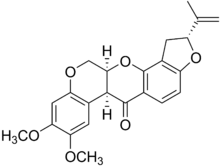Rotenoid
Rotenoids are naturally occurring substances containing a cis-fused tetrahydrochromeno[3,4-b]chromene nucleus.[1] Many have insecticidal activity, such as the prototypical member of the family, rotenone. Rotenoids are related to the isoflavones.
Natural occurrences
Many plants in the subfamily Faboideae contain rotenoids. Rotenoids can be found in Lonchocarpus sp. Deguelin and tephrosin can be found in Tephrosia vogelii.[2] 6'-O-β-D-glucopyranosyl-12a-hydroxydalpanol can be found in the fruits of Amorpha fruticosa.[3] Elliptol, 12-deoxo-12alpha-methoxyelliptone, 6-methoxy-6a,12a-dehydrodeguelin, 6a,12a-dehydrodeguelin, 6-hydroxy-6a,12a-dehydrodeguelin, 6-oxo-6a,12a-dehydrodeguelin and 12a-hydroxyelliptone can be isolated from the twigs of Millettia duchesnei.[4] Deguelin, dehydrodeguelin, rotenol, rotenone, tephrosin and sumatrol can be found in Indigofera tinctoria.[5] 6aα,12aα-12a-hydroxyelliptone can be found in the stems of Derris trifoliata.[6] Amorphol, a rotenoid bioside, can be isolated from plants of the genus Amorpha.[7] Deguelin, rotenone, elliptone and α-toxicarol can be found in the seeds of Lonchocarpus salvadorensis.[8] Clitoriacetal, stemonacetal, 6-deoxyclitoriacetal, 11-deoxyclitoriacetal, 9-demethylclitoriacetal and stemonal can be isolated from Clitoria fairchildiana.[9]
Rotenoids can also be found in the plant family Nyctaginaceae. Mirabijalone A, B, C and D, 9-O-methyl-4-hydroxyboeravinone B, boeravinone C and F, and 1,2,3,4-tetrahydro-1-methylisoquinoline-7,8-diol) can be isolated from the roots of Mirabilis jalapa.[10] Boeravinones G and H are two rotenoids isolated from Boerhavia diffusa.[11] Abronione and boeravinone C can be found in the desert annual Abronia villosa.[12] In 2015, a new rotenoid called crocetenone was extracted from the rhizome of Iris crocea.[13]
References
- Rotenoids on www.chemicool.com
- Lambert, Nadine; Trouslot, Marie-France; Nef-Campa, Claudine; Chrestin, Hervé (1993). "Production of rotenoids by heterotrophic and photomixotrophic cell cultures of tephrosia vogelii". Phytochemistry. 34 (6): 1515–1520. doi:10.1016/S0031-9422(00)90838-0.
- Lee, Hak Ju; Kang, Ha Young; Kim, Cheol Hee; Kim, Hyo Sung; Kwon, Min Chul; Kim, Sang Moo; Shin, Il Shik; Lee, Hyeon Yong (2007). "Effect of new rotenoid glycoside from the fruits of Amorpha fruticosa LINNE on the growth of human immune cells". Cytotechnology. 52 (3): 219–26. doi:10.1007/s10616-006-9040-5. PMC 3449409. PMID 19002880.
- Ngandeu, François; Bezabih, Merhatibeb; Ngamga, Dieudonne; Tchinda, Alembert T.; Ngadjui, Bonaventure T.; Abegaz, Berhanu M.; Dufat, Hanh; Tillequin, François (2008). "Rotenoid derivatives and other constituents of the twigs of Millettia duchesnei". Phytochemistry. 69 (1): 258–63. doi:10.1016/j.phytochem.2007.05.038. PMID 17640692.
- Kamal, R.; Mangla, M. (1993). "In vivo and in vitro investigations on rotenoids from Indigofera tinctoria and their bioefficacy against the larvae of Anopheles stephensi and adults of Calmlosobruchus chinensis". Journal of Biosciences. 18: 93–101. doi:10.1007/BF02703041.
- Ito, C; Itoigawa, M; Kojima, N; Tan, HT; Takayasu, J; Tokuda, H; Nishino, H; Furukawa, H (2004). "Cancer chemopreventive activity of rotenoids from Derris trifoliata". Planta Medica. 70 (6): 585–8. doi:10.1055/s-2004-815447. PMID 15229812.
- Kasymov, A. U.; Kondratenko, E. S.; Abubakirov, N. K. (1974). "Structure of amorphol — A rotenoid bioside from plants of the genus Amorpha". Chemistry of Natural Compounds. 10 (4): 470–473. doi:10.1007/BF00563810.
- Birch, Nicholas; Crombie, Leslie; Crombie, W.Mary (1985). "Rotenoids of Lonchocarpus salvadorensis: Their effectiveness in protecting seeds against bruchid predation". Phytochemistry. 24 (12): 2881–2883. doi:10.1016/0031-9422(85)80019-4.
- Pereira Da Silva, Bernadete; Paz Parente, José (2002). "Antiinflammatory activity of rotenoids from Clitoria fairchildiana". Phytotherapy Research. 16: 87–88. doi:10.1002/ptr.807. PMID 11933150.
- Yi-Fen, Wang; Ji-Jun, Chen; Yan, Yang; Yong-Tang, Zheng; Shao-Zong, Tang; Shi-De, Luo (2002). "New Rotenoids from Roots of Mirabilis jalapa". Helvetica Chimica Acta. 85 (8): 2342–2348. doi:10.1002/1522-2675(200208)85:8<2342::AID-HLCA2342>3.0.CO;2-S.
- Ahmed-Belkacem, A; MacAlou, S; Borrelli, F; Capasso, R; Fattorusso, E; Taglialatela-Scafati, O; Di Pietro, A (2007). "Nonprenylated rotenoids, a new class of potent breast cancer resistance protein inhibitors". Journal of Medicinal Chemistry. 50 (8): 1933–8. doi:10.1021/jm061450q. PMID 17341062.
- Starks, CM; Williams, RB; Norman, VL; Lawrence, JA; Goering, MG; O'Neil-Johnson, M; Hu, JF; Rice, SM; Eldridge, GR (2011). "Abronione, a rotenoid from the desert annual Abronia villosa". Phytochemistry Letters. 4 (2): 72–74. doi:10.1016/j.phytol.2010.08.004. PMC 3099468. PMID 21617767.
- Bhat, G.A.; Mir, F.; Shawl, A.S.; Ganai, B.A.; Kamili, A.N.; Masood, A.; Tantry, M.A. (March 2015). "Crocetenone, a new rotenoid with an unusual trans-fused ring system from Iris crocea". Nat Prod Commun. 10 (3): 503–4. PMID 25924539.
